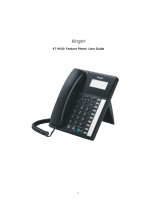
Operating Manual 15
1.3.41 ICD Group Features—Supervisory................................................................................... 96
1.3.42 Message Waiting .............................................................................................................. 97
1.3.43 Mute.................................................................................................................................. 99
1.3.44 Off-hook Monitor ............................................................................................................. 100
1.3.45 OHCA (Off-hook Call Announcement)............................................................................ 100
1.3.46 One-touch Dialing ........................................................................................................... 101
1.3.47 Paging............................................................................................................................. 102
1.3.48 Paralleled Telephone....................................................................................................... 103
1.3.49 PDN (Primary Directory Number)/SDN (Secondary Directory Number) Extension........ 104
1.3.50 Printing Message ............................................................................................................ 107
1.3.51 Privacy Release .............................................................................................................. 108
1.3.52 Private Network Features—CLIP (Calling Line Identification Presentation) ................... 109
1.3.53 Private Network Features—CLIR (Calling Line Identification Restriction) ...................... 109
1.3.54 Private Network Features—COLP (Connected Line Identification Presentation) ........... 110
1.3.55 Private Network Features—COLR (Connected Line Identification Restriction) .............. 110
1.3.56 Private Network Features—TIE Line Access.................................................................. 111
1.3.57 Quick Dialing................................................................................................................... 112
1.3.58 Redial, Last Number ....................................................................................................... 112
1.3.59 Room Status Control ...................................................................................................... 112
1.3.60 Self Labeling (KX-NT366 only) ....................................................................................... 115
1.3.61 Speed Dialing, Personal ................................................................................................. 115
1.3.62 Speed Dialing, System ................................................................................................... 116
1.3.63 SVM (Simplified Voice Message).................................................................................... 117
1.3.64 TAFAS (Trunk Answer From Any Station) ....................................................................... 126
1.3.65 Timed Reminder ............................................................................................................. 127
1.3.66 Time Service................................................................................................................... 128
1.3.67 Verification Code Entry ................................................................................................... 129
1.3.68 VOICE MAIL FEATURES................................................................................................ 130
1.3.69 Voice Mail Features—LCS (Live Call Screening)............................................................ 130
1.3.70 Voice Mail Features—Two-way Record........................................................................... 133
1.3.71 Voice Mail Features—Voice Mail Integration................................................................... 134
1.3.72 Wake-up Call................................................................................................................... 135
1.3.73 Walking COS .................................................................................................................. 137
1.3.74 Walking Extension .......................................................................................................... 138
1.3.75 Walking Extension, Enhanced ........................................................................................139
1.3.76 Whisper OHCA ............................................................................................................... 141
1.3.77 Wireless XDP Parallel Mode........................................................................................... 142
1.4 Display Features ........................................................................................................... 143
1.4.1 Call Log, Incoming .......................................................................................................... 143
1.4.2 Call Log, Outgoing .......................................................................................................... 145
1.4.3 Directories....................................................................................................................... 148
1.4.4 System Feature Access .................................................................................................. 150
2 Manager Operation............................................................................. 155
2.1 Manager Service Features ........................................................................................... 156
2.1.1 Dial Tone Transfer ........................................................................................................... 156
2.1.2 External BGM (Background Music)................................................................................. 156
2.1.3 OGM (Outgoing Messages) ............................................................................................ 157
2.1.4 Private Network Features—NDSS (Network Direct Station Selection) Monitor Release ....... 159
2.1.5 Remote Extension Dial Lock........................................................................................... 159
2.1.6 Time Service Mode Control ............................................................................................ 159




















